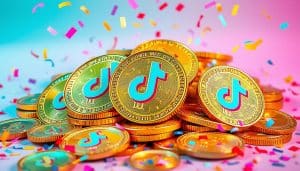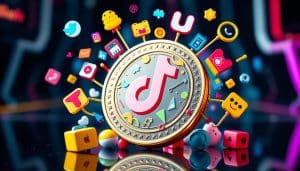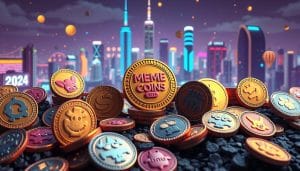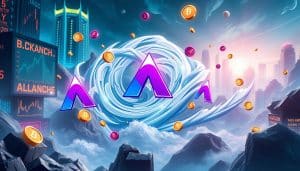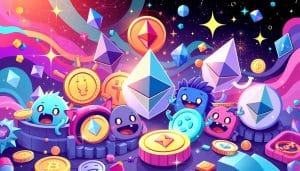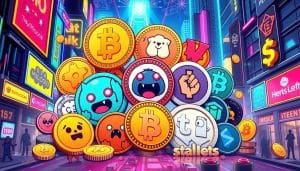Non-fungible tokens (NFTs) have become the hottest trend in the digital asset world. In fact, over $2 billion has already been invested into NFTs by investors. If you’re interested in learning more about this new technology, then this article is for you! We’ll discuss what NFTs are, their potential benefits, and how to get involved with them. We’ll also explore the impact of NFT education and awareness and what the future holds for this rapidly growing sector of blockchain technology. Finally, we’ll provide some helpful resources to get you started on your journey towards becoming an NFT expert. So let’s dive right in!
Table of Contents
ToggleDefinition and Overview of NFTs
You’ve probably heard of them, but what exactly are NFTs? Let’s dive in and explore the phenomenon that’s shaking up the world of digital art. An NFT is a non-fungible token, which essentially means it is an immutable digital asset or record stored on a blockchain network with unique characteristics that make it one-of-a-kind. The security provided by blockchain technology ensures that each NFT has a secure and traceable ownership history. Additionally, the scalability of blockchain networks make them suitable for high volume transactions and large markets surrounding virtual items. By leveraging this technology, users can buy, sell, trade, or even use their virtual assets as collateral to take out loans. As you can see, there are many advantages to using NFTs in the world of digital art and beyond—it’s no wonder they’re gaining so much attention! With all these benefits in mind, let’s take a look at how these tokens can be used further.
Benefits of NFTs
With the rise of digital assets, investing in NFTs can provide you with a unique opportunity to diversify your portfolio and enjoy some potential advantages. One major benefit of investing in NFTs is their increased security due to their use of blockchain technology and Ethereum smart contracts. This technology ensures that each token is stored on a decentralized ledger, making it nearly impossible to counterfeit or tamper with any token transactions. Additionally, by leveraging the Ethereum blockchain, users can also be sure that all transfers are secure as they go through multiple layers of encryption. Furthermore, while there are still risks associated with NFT security, these have been minimized as much as possible by the development teams behind different projects.
Understanding how Ethereum and blockchain technology works is essential for anyone looking to invest in NFTs. As such, it’s important to familiarize yourself with these concepts before taking any steps towards investing. With this knowledge in hand, investors can rest assured that their investment will be safe and secure from malicious actors or hackers seeking to exploit vulnerabilities within the system. Moving forward, it’s clear that understanding Ethereum and blockchain technology is key in order to reap the benefits of investing in NFTs.
Understanding Ethereum and Blockchain Technology
Ethereum and blockchain technology are the foundation of the NFT revolution. Ethereum is a decentralized platform that runs smart contracts, which are applications that run exactly as programmed without any possibility of fraud or censorship. The security of these transactions is ensured by Ethereum mining, which is the process of verifying transaction data on the blockchain. Blockchain technology also provides ownership security for digital assets and makes sure that they remain immutable and free from manipulation.
One must be familiar with these concepts to understand how NFTs work, since they rely on secure ownership records for digital items stored on a blockchain network. To capitalize on the potential of NFTs, it’s essential to have a deep understanding of Ethereum and blockchain technology–this knowledge will help users reap the benefits associated with this revolutionary new asset class. Moving forward, we’ll explore different types of NFTs to gain further insight into their capabilities.
Types of NFTs
NFTs come in various shapes and sizes, so it’s important to get a handle on the different types available if you want to stay ahead of the curve. At its core, an NFT is a unique digital asset that can be bought, sold, or exchanged using blockchain technology. Examples of NFTs include art pieces, collectibles, virtual real estate projects, digital tokens used for gaming items and more. Each type has its own advantages and disadvantages depending on things such as energy consumption and legal regulation.
1) Non-fungible tokens (NFTs): These are digitally scarce assets with unique qualities that make them irreplaceable;
2) Fungible tokens (FTs): FTs represent digital assets where each token is fungible and interchangeable with another;
3) Utility tokens: These are often used to access services or products within a specific platform;
4) Security tokens: These are essentially blockchain-based investments where investors receive partial ownership of a company’s stock or revenue stream.
No matter which type of NFT you decide to pursue, understanding the fundamentals is key for creating successful projects and building strong networks around them. With this knowledge in hand, it’s time to look at how to create an NFT.
How to Create an NFT
Creating an NFT is a simple three-step process. First, decide on the asset you would like to tokenize. This could be anything from digital art, music, or even physical items—the possibilities are endless! Next, use a platform to tokenize your asset so that it can be stored on the blockchain. Finally, mint your NFT and make sure it is securely hosted on the blockchain. You’re now ready to share your NFT with the world!
Decide on an Asset
Choosing the right asset for your NFT is vital – it can be the difference between success and failure! When deciding on a suitable asset, there are two main criteria to consider: asset classification and its value. The type of asset you choose will depend on your individual goals and what kind of impact you want to make with it. Is the asset a physical or digital object? It’s important to think about your target audience and how they will perceive the item. You also need to consider whether the asset has an intrinsic value or not. If it does, then this could give buyers more incentive to purchase it. Once you have an idea of what type of assets best suits your goal, then you can begin assessing their worth in terms of potential marketability. With these criteria in mind, you’ll be able to narrow down your choices until you find that perfect asset for tokenizing. Now that you know how to decide on an appropriate asset, it’s time to move onto tokenizing the asset so that it can become an NFT!
Tokenize the Asset
Now that you’ve found the perfect asset to tokenize, it’s time to make it into an NFT! The tokenizing process is a digitalized version of a physical asset – which allows ownership rights, authenticity, and other characteristics of the asset to be verified and stored on blockchain. To begin the tokenizing process:
- Decide what type of Token Standard will best suit your asset – whether it’s ERC-721 or ERC-20
- Create digital assets using tools such as Codefi Activate
- Set up a wallet to store your tokens safely
By following these steps, you can ensure that your NFT is secure and its data is validly recorded on the blockchain. With this important step out of the way, you are now ready to mint the NFT!
Mint the NFT
Minting your NFT is the final step in the tokenizing process, and it’s an exciting one! According to recent studies, over $200 million worth of NFTs have been exchanged since 2018. This demonstrates a surge in demand for NFTs as digital assets are becoming increasingly popular and accepted. When minting an NFT, you will assign it with ownership rights that are associated with a uniquely identifiable digital asset. As technology advances, marketing trends are shifting towards more creative ways to engage customers through digital platforms; thus allowing for greater opportunities when issuing an NFT. This ensures that your asset is protected by law and can be easily tracked on the blockchain ledger. Furthermore, your asset will remain yours forever due to its indestructible nature on the blockchain; giving you full control of your asset and all of its associated rights. With these benefits in mind, transitioning into exploring different platforms for creating and selling your NFTs becomes even more enticing.
Platforms for Creating and Selling NFTs
Creating and selling NFTs requires platforms that specialize in minting these digital assets. Platforms such as OpenSea, Rarible, CryptoKitties, and Decentraland are popular choices for those who wish to create and sell their own NFTs. These platforms use smart contracts to ensure the authenticity of the transactions made with NFTs. They also use token standards like ERC721 and ERC1155 to guarantee that each asset is unique and secure. Despite the advantages of using these specialized platforms, it can be challenging for new users to understand how they work or how to get started creating their own NFTs. With this in mind, it is important to consider strategies for raising awareness about the potential of creating and selling digital assets on these platforms.
Strategies for Raising Awareness
Capitalizing on the power of social media and other digital marketing strategies can be an effective way to spread the word about creating and selling NFTs. Leveraging influencer outreach, press releases, online advertising, strategic partnerships as well as content creation are all great ways to build awareness. Utilizing these methods can help target specific audiences and generate interest in the concept of NFTs. Through this approach, it is possible to reach a wide range of people who may not have heard of NFTs before. This type of outreach can also help to educate potential buyers on the different applications for non-fungible tokens and how they can become involved with them. Without a doubt, education is key when it comes to increasing public understanding regarding NFTs – something that must be addressed in order for mass adoption to occur.
Strategies for Educating the Public
You’ve got the right idea – educating the public is key to raising awareness about NFTS. There are a few strategies you can use, including hosting online events and workshops, creating tutorials and guides, or launching social media campaigns. Each strategy is effective in its own way, so it’s important to consider which ones would work best for your project.
Online Events and Workshops
Attending online events and workshops is an opportunity to explore the world of non-fungible tokens and deepen your understanding. You will learn about the terms and conditions of NFTs, platform security, trust issues, and more. It’s important to read the information carefully in order to make informed decisions on any transactions or purchases you make. Online events can be held by independent organizations or companies that have expertise in the space. They provide a great way for anyone interested in learning more about NFTs to get started. Additionally, they are often interactive so people can ask questions directly from experts which is a great way to gain clarity and confidence when it comes to making decisions regarding NFTs. To ensure safety when attending these events, it’s important to read all of the information provided beforehand including event rules, regulations, and any other relevant terms and conditions. With this knowledge, you’ll be well equipped with the understanding necessary for participating in online NFT events. From there, moving onto tutorials and guides will help further develop your skillset within this new digital realm.
Tutorials and Guides
Now that you know more about the online events and workshops available to learn more about Non-Fungible Tokens (NFTs), it’s time to explore tutorials and guides. Tutorials are an invaluable source of knowledge because they provide step-by-step instructions on how to buy, sell, manage, and create NFTs. They can also guide you through the legal implications associated with owning an NFT. It’s important to take the time to research these topics carefully before investing in them.
In addition to in-depth guides, there are also a variety of helpful buying tips that can be found online. Researching different platforms for buying NFTs is key – this will help ensure you’re dealing with reputable sellers who provide secure transactions. Keep in mind that digital assets come with their own set of risks so staying informed is paramount when investing in NFTs. With the right resources and education, anyone can start learning about this exciting new asset class! From here we’ll move onto discussing social media campaigns as another way to increase awareness around NFT technology.
Social Media Campaigns
Social media campaigns are an amazing way to skyrocket the popularity of Non-Fungible Tokens (NFTs) in no time flat! By partnering with influencers and content curators, brands can easily build trust and credibility with their target audience. This tactic can be used to spread awareness about NFTs and their potential use cases, allowing people to make informed decisions. Additionally, social media campaigns help create a sense of community around the brand, which helps increase engagement with existing customers and attract new ones. With the right strategy and execution, NFTs can reach millions in just a short amount of time!
The success of any social media campaign depends on its ability to capture attention and engage users. This poses some unique challenges when it comes to increasing NFT education and awareness. Creating content that is both informative and entertaining is essential for getting people interested in learning more about this emerging technology. Furthermore, identifying the right influencers who already have established followerships is important for driving results quickly. When done correctly, social media campaigns can be a powerful tool for accelerating NFT adoption across multiple industries.
Challenges of NFT Education and Awareness
Understanding the challenges of NFT education and awareness is key to making sure everyone can benefit from this powerful technology. The biggest challenge with NFTs is the lack of general understanding among the public regarding cryptocurrency adoption, as well as regulatory compliance:
- Many people are unaware of how cryptocurrencies work and their potential benefits.
- Regulatory frameworks in many countries are still in development, meaning that there is often a lack of clarity on regulations and legal obligations when it comes to using or trading NFTs.
- There are also high transaction fees associated with some crypto transactions, which can be off-putting for new users who may not understand why these fees exist or how they work.
- Lastly, there is a lack of trust between users due to the volatile nature and anonymous status of cryptocurrencies, which can make it difficult for people to feel comfortable investing in them or using them for purchases or trades.
By gaining an understanding of the challenges associated with NFT education and awareness, we can create better strategies moving forward that will help increase user confidence and encourage wider adoption of this technology. This will ensure that everyone can benefit from its potential benefits without feeling overwhelmed by its complexities.
Best Practices for NFT Education and Awareness
Getting up to speed with NFTs can be tricky, but there are some simple best practices that can help everyone make the most of this cutting-edge tech. First and foremost, it’s essential to become familiar with all the key NFT vocabulary and concepts. Even if you think you know the basics, taking some time to review how NFTs work and what they mean for digital ownership can give you a leg up in understanding their potential impact. Additionally, taking an active role in the community by joining discussions with other users or participating in projects related to NFTs is another great way to stay ahead of the curve. By doing so, you can gain valuable insights into how NFT technology is being used and developed around the world. With these tips in mind, anyone can become an informed participant in this new wave of digital innovation. All that’s left then is to explore what kind of real-world impact these developments could have on our lives—a discussion for another day!
Impact of NFT Education and Awareness
Gaining insight into the potential of NFT technology can open up a world of possibilities and revolutionize digital ownership, giving us a glimpse into what could be an exciting new era. The impact of NFT education and awareness is far-reaching, as more and more people can understand the implications that come with decentralized finance, collectible gaming, and other related areas. From improved security to better understanding of asset ownership, the benefits are immense:
- Increased access to digital assets for users across different demographics
- Improved transparency in financial transactions
- Greater control over individual’s data privacy
The effects of educating people about the various implications of NFT technology are already being felt in many parts of the world. It’s only by continuing to build awareness that we’ll be able to realize its full potential in creating a more equitable and secure future for all those who use it. As we move forward towards this goal, it will be important to consider how best to ensure everyone has access to these tools without sacrificing security or safety.
The Future of NFT Education and Awareness
Unlocking the future of digital asset ownership can revolutionize how we interact with technology and open up countless possibilities for users around the world. The development of Non-Fungible Tokens (NFTs) has sparked a new wave of interest in the digital asset space, but it’s also led to questions about regulations and consumer protection. NFT education and awareness will play an important role in helping people understand what these tokens are, how they work, and what rights they confer. Governments around the globe must ensure that proper regulation is put into place so that consumers are protected from any malicious activity or fraudulent schemes. As more people gain access to this technology, it’s critical that appropriate NFT regulations provide ample consumer protection while still allowing innovation to thrive. With the right education and awareness initiatives in place, we can look forward to a bright future where digital assets make life easier for everyone involved. To better understand how far we’ve come already, let’s take a closer look at some common questions and answers about NFTs.
Common Questions and Answers
With so much still to learn about Non-Fungible Tokens, it’s understandable that many people have questions about how they work and what rights they confer. To begin with, NFTs are digital assets stored on a blockchain ledger that are unique and irreplaceable like a piece of art or collectible. Unlike cryptocurrency, which is based on decentralized networks such as Bitcoin or Ethereum, NFTs do not represent any real value but instead provide access to certain data or digital content. They can be used as financial instruments, virtual goods in video games, artwork in digital galleries and more.
When it comes to the legal landscape around NFTs, there are still some uncertainties regarding cryptocurrency regulations in different countries. Moreover, since the market for NFTs is relatively new and unregulated, there is also potential for fraud and manipulation when buying and selling them on an open market. As a result, it’s important to do your research before investing in NFTs or using them as payment methods in an NFT marketplace.
In order to gain a better understanding of the technology behind these tokens and the associated risks/ rewards involved with investing in them, there are numerous resources available online from reputable sources.
Resources
Now that you know the answers to some common questions about NFTs, it’s time to take the next step in your education. There are a variety of resources available online for those interested in learning more about digital art and crypto collectibles. From articles to podcasts and videos, there’s no shortage of helpful information out there.
It can be hard to know where to start or which sources are reliable, but luckily there are several trustworthy websites dedicated solely to educating people on NFTs. These sites provide comprehensive guides, tutorials, and reviews on topics related to digital art and crypto collectibles, making it easy for anyone looking for an introduction or further knowledge on the subject. Additionally, individuals can connect with other experts in the field through forums and chatrooms for peer-to-peer advice. Whether you’re just getting started or already have some experience with NFTs, these resources can be invaluable in helping you stay up-to-date on developments in this rapidly evolving space.







